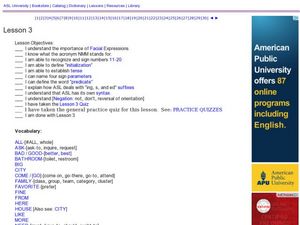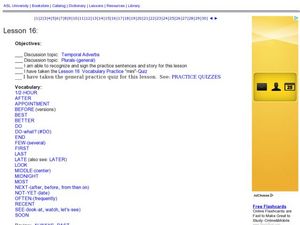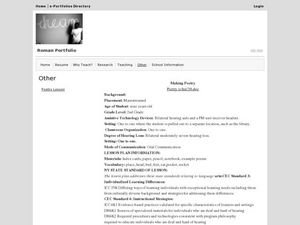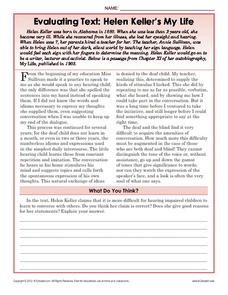Nuffield Foundation
Assessing Human Hearing
Young scientists explore hearing through multiple experiments, demonstrations, and activities. They focus on the changes in hearing over a lifetime, how we can determine where a sound is coming from, and the ability to filter noises.
Curated OER
Deaf
Intended for a main-stream class, this presentation goes over some facts they may need to know when meeting a deaf person. They learn how deaf people cope with hearing loss, communicate, and do everyday activities like watch TV or answer...
Curated OER
ASL: Lesson 13
Ever consider becoming an interpreter for a special needs or hearing impaired pupil? ASL lesson 13 focuses on becoming an interpreter and also on research. Included are many links to visual aids and video intended to guide your signing...
Curated OER
ASL: Lesson 19
Being able to express feelings is important for every learner. ASL lesson 19 is intended for teaching hearing impaired pupils or special ed teachers functional ASL. Since this provides a list of signs describing feelings, it would be a...
Curated OER
ASL Lesson 17
Learn to communicate with sign in this comprehensive series. It includes a video, images to help you sign, a quiz, and multiple practice sheets, all of which are intended to communicate wants, needs, and personal preferences. The video...
Gallaudet School for the Deaf
The History of the American School for the Deaf
To better understand the significance and history of the American School for the Deaf, hearing-impaired learners conduct research, hold discussions, and write a play. The activity spans three class periods and allows the class to explore...
Curated OER
ASL Lesson 2
Empower your non-verbal, autistic, or learning-impaired child with sign language. Lesson 2 in this functional and straight-forward series focuses on vocabulary related to familial relationships and ASL grammar. Video clips and images of...
Curated OER
ASL: Lesson 3
The ASL lessons from lifeprint are amazing, but can be complicated. While this lesson is perfect for those needing to learn or teach ASL to the deaf community, it could also provide a valuable communication tool. This resource features...
Curated OER
ASL 1: Lesson 1
Experience lesson one of an extensive American Sign Language series! Whether you are teaching ASL or learning it as a communication tool to use in your special education class, this lesson is great! Foundational signs, such as finger...
Curated OER
Learning ASL: Lesson 9
Here is lesson 9 in an extensive series on teaching and learning ASL. Discuss code switching, numerical incorporation, and noun based vocabulary. Then, click on the blue links to view ASL in action. Each link takes you to a printable...
Curated OER
ASL: Lesson 16
ASL lesson 16 covers adverbs of time, sentence structure, and asking questions. Each blue link takes you to an image, instructions, or video of the word/s being signed. Great resource!
Curated OER
ASL: Lesson 20
Teach it, learn it, communicate with it. ASL is at your fingertips with this sign language series. Lesson 20 focuses on classifiers, descriptive vocabulary, and asking questions. Each blue link on the page takes you to an image or video...
Curated OER
For iPod Users, a Budding Problem
Students explore hearing loss in teens. In this health journalism lesson, students read the USA Today article titled "For iPod Users, a Budding Problem," respond to discussion questions regarding the article, and complete an activity...
Curated OER
Making Poetry
A hearing impaired student identifies rhyming words. In this rhyming word lesson for the hearing impaired, 2nd graders read and write poetry correctly using rhyming words.
Curated OER
Learning to Summarize a Story
Students with hearing loss read independently and understand what is being read to them. In this independent reading lesson plan, students sequence and discuss the book that is read.
Curated OER
The Senses: Hearing and Sight
Eighth graders consider how they use their senses. In this biology lesson plan, 8th graders understand the definition of a disability and how it affects Americans who are hearing impaired or deaf, and those Americans who are visually...
Curated OER
How Do I know That a Book Is Just Right for Me to Read?
Students choose a book for reading. In this language arts lesson, students take steps to evaluate a book for free reading. Students make a list of words found in the book that they are unfamiliar with.
K12 Reader
Evaluating Text: Helen Keller's "My Life"
Readers are asked to evaluate Helen Keller's claim, and the evidence she uses to support her argument, that it is more difficult for hearing impaired children to learn to talk with others.
Curated OER
TE Activity: Sound Line
Students investigate the decibel readings of various noises. They determine why high-level readings damage hearing. Students arrange sound from the lowest to highest decibel levels when they written on a piece of paper.
Curated OER
Helen Keller- Book Marks
Students learn about the life of Helen Keller. In this cultural and disability awareness activity, students read a biography about Helen Keller and discuss the differences in her life and theirs. Students discuss which sense they would...
Curated OER
ASL Lesson 18
Have a discussion, review nouns, and practice speaking using ASL. Lesson 18 of 30+ extensive lessons on using American Sign Language covers classifiers, coded English, and asking questions. Each link embedded in the lesson provides a...
Curated OER
Special Senses- Hearing and Equilibrium
In this health worksheet, students examine the human body and make mental connections to the target function highlighted in the sheet.
Curated OER
Understanding to Read and Describe It
Second graders, with hearing disability, practice vocabulary building strategies. In this vocabulary strategy lesson, a student practices sight words using word cards. The student verbalizes a sentence with the new words while the...
Curated OER
Thai Children's Trust: School for the Blind
Students explore their five senses by experimenting with classmates. In this blindness lesson, students utilize blindfolds while performing everyday activities and discuss the inherent challenges of not having vision. Students view a...

























